
(Produkt nie został jeszcze oceniony)
kompozytor
różni kompozytorzy
tytuł
Classical Oboe Concertos
pełny spis kompozytorów
Dittersdorf, Carl Ditters von, Hoffmann, Johann, Mozart, Wolfgang Amadeus, różni kompozytorzy
wykonawcy
Puskunigis, Andrius, St. Christopher Chamber Orchestra
nr katalogowy
95218
opis
There are about one hundred classical oboe concertos, most of which were composed by oboists hoping to promote appreciation of their own skills. Following in their footsteps, the Latvian oboist Andrius Puskunigis has compiled a recording of four concertos for oboe and oboe d’amore that represent the classic Viennese style. From around 1750, the oboe, an instrument hitherto largely used in chamber and church music, began to make its way into concert halls, and to be played by virtuoso soloists. The instrument’s construction was evolving to increase the penetration of its hi register, making it more suitable both as an orchestral and a concertante instrument. Even so, the oboe of Mozart’s day could still only play two keys, thus restricting its technical range of available music and expression. Mozart overcame those limitations most wholly successfully, as one might imagine, but none of the other works here is negligible. His friend Carl Ditters van Dittersdorf composed four concertos for the instrument and its close but obsolescent relative, the sweeter and gentler oboe d’amore, which is heard here in the A major concerto.
• Dittersdorf: Concerto for Oboe D'Amore in A Major, L.43b
• Ferlendis: Concerto for Oboe No. 1 in F major
• Hofmann, L: Oboe Concerto in C major (Badley C2)
• Mozart: Oboe Concerto In C major, K314
• Mozart: Oboe Concerto in C, K285d
Works:
• Dittersdorf: Concerto for Oboe D'Amore in A Major, L.43b
• Ferlendis: Concerto for Oboe No. 1 in F major
• Hofmann, L: Oboe Concerto in C major (Badley C2)
• Mozart: Oboe Concerto In C major, K314
• Mozart: Oboe Concerto in C, K285d
nośnik
CD x 1
wydawca
Brilliant Classics
data wydania
13.11.2019
EAN / kod kreskowy
5028421952185
55,00 zł
Produkt na zamówienie
Wysyłka ustalana indywidualnie.
Darmowa wysyłka dla zamówień powyżej 300 zł!
Darmowy kurier dla zamówień powyżej 500 zł!
sprawdź koszty wysyłki